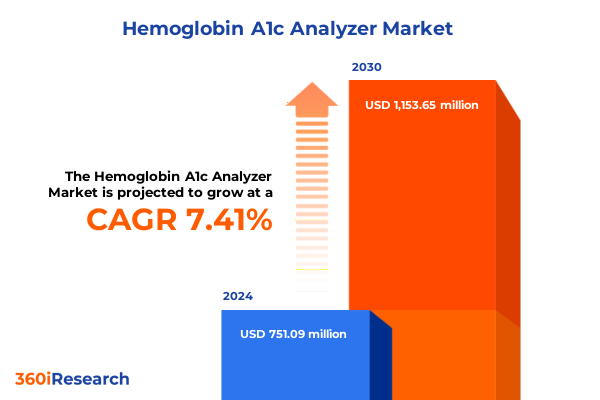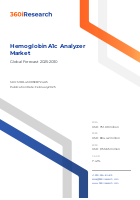The Hemoglobin A1c Analyzer Market size was estimated at USD 751.09 million in 2024 and expected to reach USD 804.42 million in 2025, at a CAGR 7.41% to reach USD 1,153.65 million by 2030.

Introduction to the Hemoglobin A1c Analyzer Market
The hemoglobin A1c analyzer market plays a pivotal role in diabetes management by providing critical metrics for long-term glycemic control. As the prevalence of diabetes rises globally, healthcare systems increasingly rely on precise, efficient, and accessible diagnostic tools to monitor patient outcomes and adjust therapeutic regimens. Recent advances in instrumentation, software integration, and point-of-care testing have elevated the strategic importance of A1c analyzers across clinical laboratories, hospitals, homecare settings, and research institutes. By synthesizing technological innovation with evolving healthcare delivery models, this report examines the key drivers, challenges, and opportunities shaping the competitive landscape. It aims to equip decision-makers with actionable insights into the current state of the market, anticipated regulatory and policy impacts, and strategic pathways for growth.
Transformative Shifts in the Hemoglobin A1c Testing Landscape
The past few years have witnessed transformative shifts that are redefining how hemoglobin A1c testing is conducted and leveraged. First, digital integration has become ubiquitous: cloud-based data management software and statistical analysis tools now interface seamlessly with laboratory information systems, enabling real-time clinician access and population health analytics. Second, the rise of portable and point-of-care analyzers has decentralized testing, empowering primary care providers, community clinics, and even patients themselves to obtain rapid results outside conventional laboratories. Third, artificial intelligence and advanced algorithms are enhancing assay interpretation, reducing manual review, and optimizing quality control workflows. Finally, regulatory bodies are tightening data security and quality standards, prompting manufacturers to invest in robust calibration kits, quality control materials, and reagent formulations that comply with evolving guidelines. Combined, these shifts are driving a new era of patient-centric, data-driven diabetes care.
Cumulative Impact of United States Tariffs in 2025
The imposition of additional tariffs on imported laboratory instruments and consumables in 2025 has had a cumulative impact on both suppliers and end users. Manufacturers relying on overseas production lines have absorbed higher input costs for bench-top analyzers, portable systems, calibration kits, and reagent kits, leading some to reevaluate supply chain strategies. To mitigate margin pressures, several producers have accelerated localization efforts, establishing regional manufacturing hubs in North America and leveraging near-shore partners for critical quality control materials. Meanwhile, diagnostic laboratories and hospitals have negotiated long-term contracts to lock in pricing or shifted part of their procurement to domestic distributors of data management software and statistical analysis platforms. Although tariff-induced cost increases have modestly elevated test prices in some segments, the response has underscored the market’s resilience and its capacity to adapt through strategic sourcing and operational efficiency enhancements.
Key Segmentation Insights
A granular look at market segmentation reveals a multifaceted structure. Based on product type, the landscape comprises consumables, instruments, and software, with consumable offerings such as calibration kits, quality control materials, and reagent kits forming a vital revenue stream, instruments including bench-top analyzers and portable systems driving core testing capabilities, and data management software alongside statistical analysis software enabling seamless workflow integration. From a technology perspective, assays employ boronate affinity chromatography, direct enzymatic assays, immunoassays-subdivided into enzyme immunoassay and turbidimetric immunoassay-and ion-exchange HPLC, each tailored to diverse clinical requirements. Testing type segments span home care testing, laboratory testing, and point-of-care testing, reflecting growing demand for decentralized diagnostics. End users range from academic and research institutes and diagnostic laboratories to homecare settings and hospitals, each presenting distinct volume, compliance, and service expectations. Applications cover diabetes diagnosis, diabetes monitoring, and broader health and wellness monitoring. Finally, distribution channels include medical and diagnostic laboratory stores, online stores, and retail pharmacies, highlighting evolving procurement preferences across clinical and consumer markets.
This comprehensive research report categorizes the Hemoglobin A1c Analyzer market into clearly defined segments, providing a detailed analysis of emerging trends and precise revenue forecasts to support strategic decision-making.
- Product Type
- Technology Used
- Testing Type
- End-User
- Application
- Distribution Channel
Key Regional Market Insights
Regional dynamics continue to shape competitive positioning and growth potential. In the Americas, established reimbursement frameworks and high healthcare spending support widespread adoption of advanced analyzers and consumables, while increasing penetration of portable analyzers expands access in rural and underserved areas. Europe, the Middle East & Africa benefit from stringent regulatory harmonization under CE marking, driving standardization and quality assurance, especially within diagnostic laboratories and academic research centers, although reimbursement variability poses adoption challenges in certain markets. The Asia-Pacific region exhibits robust growth driven by rising diabetes prevalence, government initiatives to expand community screening programs, and a surge in homecare and point-of-care testing demand, prompting manufacturers to tailor low-cost, easy-to-use platforms compatible with local infrastructure constraints.
This comprehensive research report examines key regions that drive the evolution of the Hemoglobin A1c Analyzer market, offering deep insights into regional trends, growth factors, and industry developments that are influencing market performance.
- Americas
- Asia-Pacific
- Europe, Middle East & Africa
Key Company Competitive Insights
Competitive intensity remains high as leading diagnostic and life sciences firms vie for market share through product innovation, strategic partnerships, and geographic expansion. Abbott Laboratories leverages its immunoassay expertise to broaden point-of-care offerings, while ACON Laboratories, Inc. focuses on portable analyzers optimized for community screening. ARKRAY, Inc. and Chek Diagnostics invest heavily in calibration kits and quality control materials, ensuring assay accuracy. Bio-Rad Laboratories, Inc. and EKF Diagnostics Holdings plc emphasize reagent kit diversity, and Danaher Corporation integrates software capabilities through acquisitions. Diazyme Laboratories, Inc. and Hoffmann-La Roche Ltd drive enzymatic assay developments, while HORIBA, Ltd. and i-SENS, Inc. lead in benchtop precision. Medline Industries, Inc. and PTS Diagnostics cater to homecare settings, and Menarini Diagnosticos S.A. anchors its presence in Europe. Mindray Medical International Limited and Shenzhen Mindray Bio-Medical Electronics Co., Ltd. expand low-cost analyzers in Asia-Pacific. OSANG Healthcare Co., Ltd., Quidel Corporation, Randox Laboratories Ltd., Siemens Healthineers AG, Sysmex Corporation, Tosoh Corporation, and Trividia Health, Inc. further diversify portfolios across instruments, consumables, and software.
This comprehensive research report delivers an in-depth overview of the principal market players in the Hemoglobin A1c Analyzer market, evaluating their market share, strategic initiatives, and competitive positioning to illuminate the factors shaping the competitive landscape.
- Abbott Laboratories
- ACON Laboratories, Inc.
- ARKRAY, Inc.
- Bio-Rad Laboratories, Inc.
- Chek Diagnostics
- Danaher Corporation
- Diazyme Laboratories, Inc.
- EKF Diagnostics Holdings plc
- Erba Mannheim
- Hoffmann-La Roche Ltd
- HORIBA, Ltd.
- i-SENS, Inc.
- Medline Industries, Inc.
- Menarini Diagnosticos S.A.
- Mindray Medical International Limited
- Ningbo Medicalsystem Biotechnology Co., Ltd.
- OSANG Healthcare Co., Ltd.
- PTS Diagnostics
- Quidel Corporation
- Randox Laboratories Ltd.
- Shenzhen Mindray Bio-Medical Electronics Co., Ltd.
- Siemens Healthineers AG
- Sysmex Corporation
- Tosoh Corporation
- Trividia Health, Inc.
Actionable Recommendations for Industry Leaders
Industry leaders should consider several strategic actions. First, accelerate investment in portable and point-of-care analyzers to capitalize on decentralized testing trends and expand into homecare settings. Second, form alliances with local distribution partners to mitigate tariff impacts and streamline access to calibration kits, quality control materials, and reagent kits in key markets. Third, prioritize software integration by developing or acquiring data management and statistical analysis tools that enhance interoperability with electronic health records and laboratory information systems. Fourth, bolster supply chain resilience through a dual sourcing model that balances domestic manufacturing hubs with near-shore suppliers. Finally, engage proactively with regulatory agencies to influence standards for immunoassay, enzymatic, and HPLC methods, ensuring new product launches align with evolving quality and data security requirements.
Explore AI-driven insights for the Hemoglobin A1c Analyzer market with ResearchAI on our online platform, providing deeper, data-backed market analysis.
Ask ResearchAI anything
World's First Innovative Al for Market Research
Conclusion and Future Outlook
The hemoglobin A1c analyzer market stands at a strategic inflection point driven by technological innovation, shifting healthcare delivery models, and policy dynamics. By embracing decentralized testing through portable and point-of-care platforms, reinforcing supply chain agility in response to tariff pressures, and deepening software integration for data-driven decision-making, manufacturers and stakeholders can capture emerging opportunities. Continued collaboration with regulatory authorities and end-users will ensure that product roadmaps address quality, compliance, and data security imperatives. Ultimately, organizations that align their strategic investments with patient-centric care models and leverage digital ecosystems will set the benchmark for next-generation diabetes management solutions.
This section provides a structured overview of the report, outlining key chapters and topics covered for easy reference in our Hemoglobin A1c Analyzer market comprehensive research report.
- Preface
- Research Methodology
- Executive Summary
- Market Overview
- Market Dynamics
- Market Insights
- Cumulative Impact of United States Tariffs 2025
- Hemoglobin A1c Analyzer Market, by Product Type
- Hemoglobin A1c Analyzer Market, by Technology Used
- Hemoglobin A1c Analyzer Market, by Testing Type
- Hemoglobin A1c Analyzer Market, by End-User
- Hemoglobin A1c Analyzer Market, by Application
- Hemoglobin A1c Analyzer Market, by Distribution Channel
- Americas Hemoglobin A1c Analyzer Market
- Asia-Pacific Hemoglobin A1c Analyzer Market
- Europe, Middle East & Africa Hemoglobin A1c Analyzer Market
- Competitive Landscape
- ResearchAI
- ResearchStatistics
- ResearchContacts
- ResearchArticles
- Appendix
- List of Figures [Total: 28]
- List of Tables [Total: 460 ]
Call-To-Action: Engage with Ketan Rohom for the Full Report
Unlock deeper insights and strategic guidance on the hemoglobin A1c analyzer market by connecting with Ketan Rohom (Associate Director, Sales & Marketing) to secure your comprehensive market research report. His expertise will guide you through the data, methodologies, and recommendations essential for informed decision-making and sustained competitive advantage.

- How big is the Hemoglobin A1c Analyzer Market?
- What is the Hemoglobin A1c Analyzer Market growth?
- When do I get the report?
- In what format does this report get delivered to me?
- How long has 360iResearch been around?
- What if I have a question about your reports?
- Can I share this report with my team?
- Can I use your research in my presentation?




